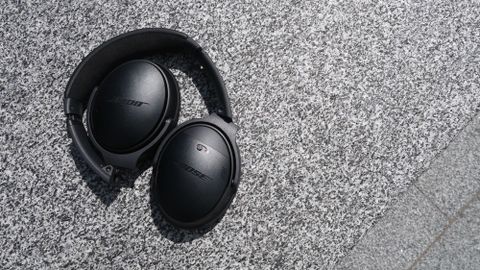TechRadar Verdict
The market leader in noise-cancelling headphones has gone wireless, and you're not going to be missing those wires any time soon.
Pros
- +
Broad and clear soundstage
- +
Amazing noise cancellation
- +
Long battery life
- +
Quick and hassle-free pairing
Cons
- -
Active EQ an acquired taste
- -
Boring looks
Why you can trust TechRadar
The QuietComfort 35 headphones brought wireless operation to the iconic Bose noise-cancelling headphones for the first time – and while they've since been upgraded in the form of the QuietComfort 35 II, these headphones remain an impressive proposition.
The headphones that came before these, the Bose QuietComfort 25 , enjoyed a huge amount of success after arriving in 2014. In the years since, the number of wireless models on the market has exploded, meaning Bose had to make the jump to wireless sooner or later.
What really impresses with the the QuietComfort 35 headphones is the way that the famous audio brand managed to cut the wires with very few compromises.
Battery life has improved to the extent that you don't constantly have to worry about your headphones running out of juice midway through a flight, while NFC technology makes pairing as easy as tapping twice.
If you need more features – like a built-in voice assistant – you can jump up to the Bose QuietComfort 35 II that we've already mentioned, offering everything you see here plus some new bells and whistles.
But, if you like your smart assistants confined to your phone and smart speaker, the original QuietComfort 35 remains one of the best noise-cancelling headphones on the market. Read on for our full review and don't forget to see what Bose promo codes are out there.
Bose QuietComfort 35: design
Anyone who's ever laid eyes on Bose's QuietComfort 25s will find the 35s instantly familiar. The simple design of their oval earcups might not be the most exciting on the market, but I personally prefer them to some of the more 'fashionable' efforts of Bose's competitors.
The headphones are available in black or silver, and on each earcup is a Bose logo which, although raised slightly, doesn't draw too much attention.
The headband connecting the two earcups is well padded, and the way the headphones sit on your head is very comfortable overall. Partly this is because their weight is nicely distributed, but it's also partly because of the quality of the cushioning on the cups. I have personally worn these headphones for hours at a time and have found them to be comfortable throughout.
On the left earcup is a single 2.5mm jack for connecting the wired connection to your device, but in order to get the most out of the QuietComfort 35s your attention should instead be focused on the right earcup where you'll find a power slider, micro USB charging port, and buttons for pausing, skipping, raising and lowering the volume (which work with both iOS and Android, unlike the QC25s).
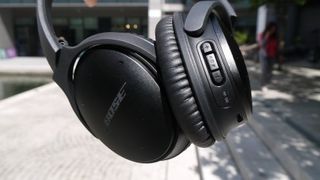
Pairing the QC35s is a breeze. You slide the power slider all the way to the right to put the headphones in pairing mode, and then you simply select them from your phone or laptop's Bluetooth menu.
Alternatively if your phone is one of the increasing amounts of Android phones that support NFC pairing then you can connect your headphones by simply putting them in pairing mode and tapping the rear of your phone against them.
The headphones are very good at switching between multiple connections. I had my pair of QC35s connected to both my laptop and my phone, and the headphones had no trouble switching between the two as I played music alternately from both devices.
Battery life on the QC35s is very good. Bose promises that the headphones will last 20 hours when operating wirelessly, which rises to 40 hours when used as a pair of wired headphones. I didn't time exactly how long the battery took to run down, but the headphones lasted me several days of on and off use before needing to be recharged.
It's a minor point, but whenever you turn the headphones on they helpfully play a short audio notification of both the device they're connected to as well as how much battery life is left. It rounds this to the closest 10%, but it's still a helpful indicator to have.
Finally these Bose QuietComfort 35 headphones do include a mic which allows them to be used as a headset for making phone calls and the same noise-cancelling technology is used on the mic to eliminate background noise.
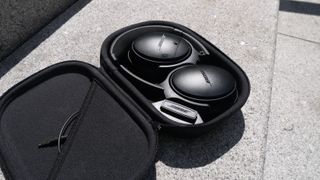
Bose QuietComfort 35: performance
When it comes to Bluetooth music streaming there's standard Bluetooth and then there's AptX Bluetooth. The latter is appreciably better for streaming music, but Apple's devices only support the former. You can read more about the difference between them in our Bluetooth vs AptX explainer.
When I asked a spokesperson from Bose about the lack of support their response was that the company felt the quality offered by standard Bluetooth was good enough, but it's nevertheless a shame not to see high-fidelity audio properly supported.
The good news is that in spite of the lack of AptX support the QC35's wireless performance doesn't feel lacking in the slightest. Their sound is lovely and crisp, and there's none of the flatness that you can get with wireless headphones.
The soundstage on these headphones is phenomenally broad, and when paired with a high-quality recording such as Massive Attack's Unfinished Symphony it's very easy to feel immersed in the sound.
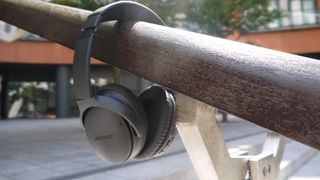
Switch to a track with a bit more speed like Uncombed Hair by Yung and you'll notice just how much punch the QC35s have in their bass, which adds a good amount to the rhythm of the song.
I wasn't completely sold on the Active EQ features of the headphones which boosts the bass frequencies slightly as you lower the volume to compensate for how lower volumes tend to bias higher frequencies.
In my subjective tests this effect often ended up making the tracks feel ever so slightly too bassy at lower frequencies.
But the real star of the show when it comes to Bose's QuietComfort range is the noise cancelling, and I'm happy to say the QC35's are as good as ever.
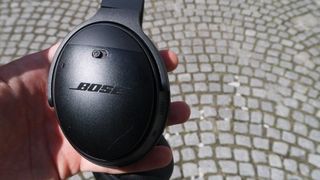
As with all noise-cancelling headphones, the QC35's are best at cancelling out consistent low frequencies like the rumble of a train or plane rather than higher-pitched office chatter, but even the latter is drowned out to a certain extent by the padding around the headphone's earcups.
The noise-cancelling sensation is a little odd at first and feels a little like being in a pressurised cabin, but you soon get used to actually being able to listen to your music rather than the world around you.
It's also strange using the headphones when they're cancelling out the noise around you (including your own voice), but the microphone works very well despite not being located on a cable closer to your mouth like most wired headphones.
I used the headphones for a half hour video call in a noisy office and was perfectly audible throughout thanks to the efforts of the noise-cancelling technology.
We liked
The Bose QuietComfort 35s offer great sound quality and the best noise cancelling out of any headphones I've tried. They're super comfortable, and despite the fact that they don't use the newer AptX Bluetooth standard, the wireless doesn't harm their sound quality one bit.
We disliked
The Active EQ is subtle, but personally I don't think it added anything to my listening experience.
Verdict
The best noise-cancelling headphones go wireless, and you won't miss the annoying tangled cable one bit. The Bose QuietComfort 35 headphones sound every bit as good as their wired brethren, and offer all of the convenience of wireless headphones with none of the drawbacks that used to plague them – just compare prices with the Bose QuietComfort 35 before buying.
- Looking to cut the cord? These are the best wireless headphones
Jon Porter is the ex-Home Technology Writer for TechRadar. He has also previously written for Practical Photoshop, Trusted Reviews, Inside Higher Ed, Al Bawaba, Gizmodo UK, Genetic Literacy Project, Via Satellite, Real Homes and Plant Services Magazine, and you can now find him writing for The Verge.
